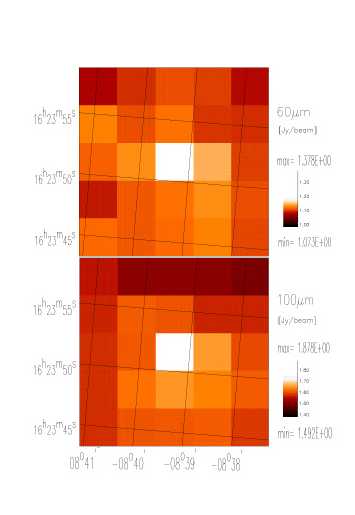A team from Observatoire de Paris has observed the variations of the thermal Infra-red flux of the Pluto-Charon system. Such variations prove that the surface of Pluto is not isothermal. The measurements provide an estimate of the thermal inertia of Pluto’s surface as well as indications about its physical nature.
The Pluto-Charon system is unique in the Solar System. The two bodies, of similar sizes (respective diameters 2320 and 1180 km), orbit around their common center of gravity with a 6.4 day period. This time interval also corresponds to the rotation of each body about its polar axis ; therefore, each of the two bodies permanently exhibit a same side to the other.
Observations with ISOPHOT, performed by a team led by Emmanuel Lellouch (Observatoire de Paris, DESPA), provided the first unambiguous detection of the "light curve" of the Pluto-Charon system at thermal wavelengths (Fig. 1).

As a matter of fact it is a "temperature curve" : at some orbital positions, the system emits more thermal flux (thermal energy) than at others, implying that the regions seen from the Earth at that time are warmer. It has been known for a long time that Pluto’s surface is not uniform. In particular, the solar light (in the visible range) reflected by Pluto, reproducibly varies with the 6.4 day period. Thus the visual magnitude of Pluto varies with its position on its orbit (measured by its longitude ranging from 0 to 360 degrees). Pluto emits a maximum of visible light at a longitude L = 220 degree and a minimum near L = 100. Conversely the measurements made by the ISOPHOT camera mounted on the ISO satellite, show (Fig. 2) a maximum thermal flux of the Pluto-Charon system around L = 80 and a minimum around L = 240.

This general anti-correlation with the visible light curve is normal : it is expected that the darker regions of Pluto are warmer that the brighter ones. Indeed, the darker regions absorb more the solar energy, they warm up more and therefore emit a larger infra-red flux. The coldest regions have a temperature of 35-40K, while the warmest may reach 55-65K. The detailed analysis of the ISO measurements shows, in addition, that the anti-correlation is not perfect, but the thermal "light curve" is actually slightly shifted ("delayed") relative to the visible light curve. From this shift, the thermal inertia of Pluto’s surface may be measured, suggesting that the material of the darkest regions is probably porous.
This work is detailed in a paper accepted for publication by the international journal Icarus. ISO has been built by the European Space Agency. The DESPA (UMR 8632) is a department of the Observatoire de Paris, partially supported by CNRS.
Details : Emmanuel.Lellouch chez obspm.fr
Press contact : Martine.Mathieu chez obspm.fr
